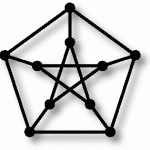Kuratowski’s Theorem may be stated as follows:
Let ![]() be a graph.
be a graph. ![]() is nonplanar if and only if
is nonplanar if and only if ![]() contains a subdivision of either
contains a subdivision of either ![]() or
or ![]() as a subgraph.
as a subgraph.
In the talk, we use the following definition of a graph:
Let ![]() and
and ![]() be sets.
be sets. ![]() is a graph if and only if it satisfies the following conditions:
is a graph if and only if it satisfies the following conditions:
1) ![]() (edges),
(edges),
2) for all ![]() ,
, ![]() (no loops), and
(no loops), and
3) ![]() implies
implies ![]() (edge symmetric).
(edge symmetric).
Elements ![]() are called vertices and
are called vertices and ![]() are edges. As
are edges. As ![]() is edge symmetric (that is, it satisfies our third criterion above), it will be expedient to refer to both
is edge symmetric (that is, it satisfies our third criterion above), it will be expedient to refer to both ![]() as the same object
as the same object ![]() .
.
A graph ![]() is said to be planar if and only if there exists an isomorphic planar embedding of the graph in
is said to be planar if and only if there exists an isomorphic planar embedding of the graph in ![]() . That is,
. That is, ![]() is planar provided it can be drawn in the euclidean plane such that edges of the graph cross precisely when there is a vertex, and nowhere else.
is planar provided it can be drawn in the euclidean plane such that edges of the graph cross precisely when there is a vertex, and nowhere else.
It will be necessary to include further definitions in the talk. However, for the moment, these capture the structures with which we shall be dealing.
We begin by motivating the idea of a nonplanar graph with an interesting puzzle. From here, I shall provide a simple proof of the sufficiency of Kuratowski’s Theorem and a sketch of a proof of the necessity, as well as complete proofs of several other related results.
Sources: Bondy, J. Graph Theory. New York: Springer, 2008.


